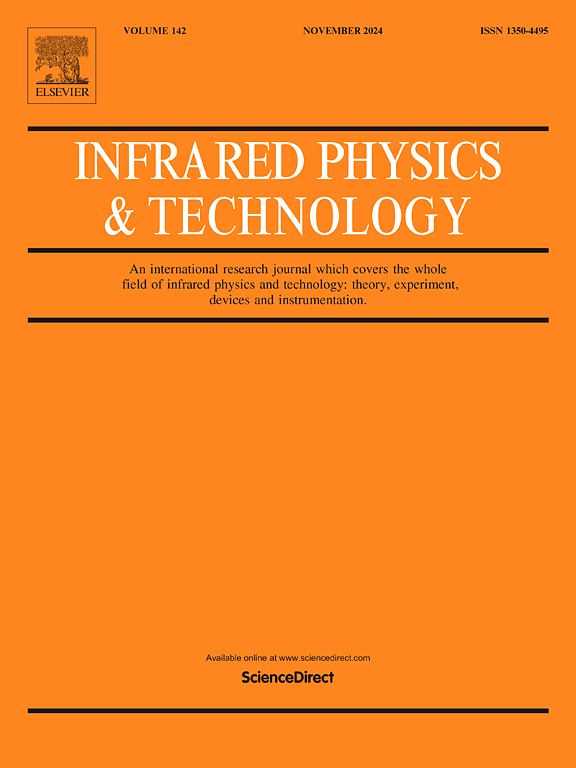基于空频域交叉学习的红外与可见光图像融合网络
IF 3.1
3区 物理与天体物理
Q2 INSTRUMENTS & INSTRUMENTATION
引用次数: 0
摘要
红外图像与可见光图像融合的目标是结合源图像的互补信息生成高对比度的融合图像,在保留丰富纹理细节的同时突出突出目标。大多数基于深度学习的融合方法只关注空间域,而忽略了有价值的频域信息。此外,现有的空频融合网络未能充分利用这两个领域的优势,导致融合性能有限。为了解决这一挑战,我们提出了一种用于红外和可见光图像融合的空频域交叉学习网络(SFCFusion)。具体来说,我们设计了一个频域学习分支,在傅里叶空间中捕获全局特征信息,从而更有效地保持源图像的全局一致性。此外,我们开发了一个空间分支来提取局部细节特征,并提出了一个多尺度选择性增强模块(MSEM)。最后,当桥接频率和空间分支时,我们观察到这两个分支提取的特征信息是互补的。为了利用这一特性,我们设计了一个频率-空间交叉制导模块(FSCGM)。该模块采用双向引导学习策略,将两个领域的关键信息整合到每个分支中,从而提高融合图像的质量。在公共数据集上的大量实验表明,我们的方法在关键融合性能指标和视觉质量方面取得了显著的优势。它在下游检测任务中也表现出强大的性能。我们的代码可在https://github.com/HaodeShi/SFCFusion上获得。本文章由计算机程序翻译,如有差异,请以英文原文为准。
Infrared and visible image fusion network based on spatial-frequency domain cross-learning
The goal of infrared and visible image fusion is to combine complementary information from source images to generate fused images with high contrast, which can highlight salient targets while preserving rich texture details. Most deep learning-based fusion methods focus solely on the spatial domain, neglecting valuable frequency domain information. Furthermore, existing spatial-frequency fusion networks fail to fully exploit the advantages of both domains, resulting in limited fusion performance. To address this challenge, we propose a Spatial-Frequency Domain Cross-Learning Network (SFCFusion) for infrared and visible image fusion. Specifically, we have designed a frequency-domain learning branch that captures global feature information in the Fourier space, thereby more effectively preserving the global consistency of the source images. Additionally, we develop a spatial branch to extract local detail features and propose a Multi-scale Selective Enhancement Module (MSEM). Finally, when bridging the frequency and spatial branches, we observe that the feature information extracted from these two branches are complementary. To leverage this property, we design a Frequency-Spatial Cross-Guidance Module (FSCGM). This module employs a bidirectional guidance learning strategy to integrate critical information from both domains into each branch, thereby enhancing the quality of fused images. Extensive experiments on public datasets demonstrate that our method achieves significant advantages in terms of key fusion performance metrics and visual quality. It also exhibits robust performance in downstream detection tasks. Our code is available at https://github.com/HaodeShi/SFCFusion.
求助全文
通过发布文献求助,成功后即可免费获取论文全文。
去求助
来源期刊
CiteScore
5.70
自引率
12.10%
发文量
400
审稿时长
67 days
期刊介绍:
The Journal covers the entire field of infrared physics and technology: theory, experiment, application, devices and instrumentation. Infrared'' is defined as covering the near, mid and far infrared (terahertz) regions from 0.75um (750nm) to 1mm (300GHz.) Submissions in the 300GHz to 100GHz region may be accepted at the editors discretion if their content is relevant to shorter wavelengths. Submissions must be primarily concerned with and directly relevant to this spectral region.
Its core topics can be summarized as the generation, propagation and detection, of infrared radiation; the associated optics, materials and devices; and its use in all fields of science, industry, engineering and medicine.
Infrared techniques occur in many different fields, notably spectroscopy and interferometry; material characterization and processing; atmospheric physics, astronomy and space research. Scientific aspects include lasers, quantum optics, quantum electronics, image processing and semiconductor physics. Some important applications are medical diagnostics and treatment, industrial inspection and environmental monitoring.

 求助内容:
求助内容: 应助结果提醒方式:
应助结果提醒方式:


